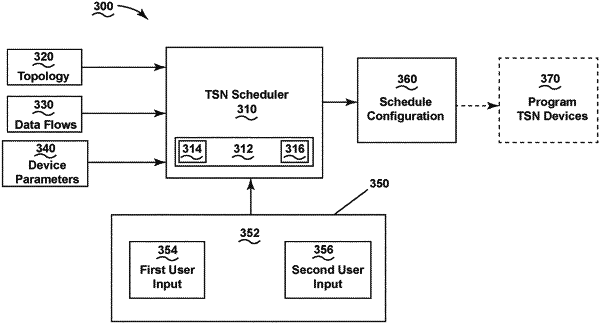| CPC H04L 41/12 (2013.01) [H04L 47/28 (2013.01); H04L 67/62 (2022.05)] | 18 Claims |

|
11. A system for generating a time-sensitive network (TSN) schedule for a desired TSN, the system comprising:
a set of topology input data, stored in a memory, defining an arrangement of the desired TSN including at least a set of end nodes communicative connected by way of a set of switching nodes;
a set of data flow input data, stored in the memory, defining communication pathways between the set of end nodes by way of the set of switching nodes;
a set of device parameter input data, stored in the memory, for each of the set of end nodes and each of the set of switching nodes of the desired TSN, including at least a transmission start delay; and
a TSN scheduler, configured to receive the set of topology input data, the set of data flow input data, and the set of device parameter input data, for each of the set of end nodes and each of the set of switching nodes, and to operate, based on a user input, in a contiguous scheduling mode including a data flow timing buffer to ensure no data flow overlap or collisions are scheduled to:
determine a back-to-back TSN schedule for the desired TSN based on the set of topology input data, the set of data flow input data, and the set of device parameter input data, for each of the set of end nodes and each of the set of switching nodes; and
generate a respective per-device configuration for each of the set of end nodes and each of the set of switching nodes of the desired TSN, based on the determined back-to-back TSN schedule;
wherein in the event the contiguous scheduling mode cannot be completed, the TSN scheduler is configured to default to another scheduling mode; and
wherein each of the set of end nodes and each of the set of switching nodes of the desired TSN are operable in accordance with the respective per-device configuration.
|